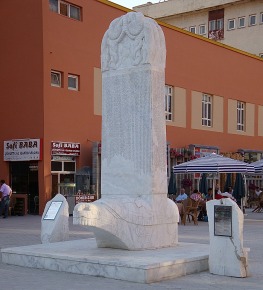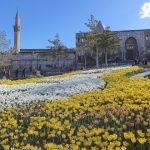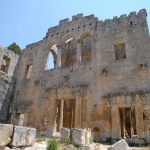Capital of the Karamanoğlu Emirate Population: 175,400
Old name: Laranda
Market day: Wednesday
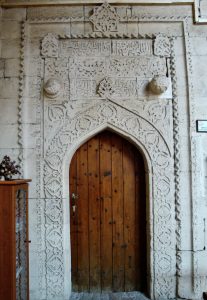 Right in the heart of Anatolia lies a slender triangle whose angles turn on three towns beginning with “K” — Konya, Kayseri and Karaman. Konya is world famous as the burial place of Mevlana, and Kayseri is familiar to many visitors as one of the gateways to Cappadocia.
Right in the heart of Anatolia lies a slender triangle whose angles turn on three towns beginning with “K” — Konya, Kayseri and Karaman. Konya is world famous as the burial place of Mevlana, and Kayseri is familiar to many visitors as one of the gateways to Cappadocia.
But Karaman? Most guidebooks have nothing to say about the town in spite of the fact that it was, from 1256 to 1487, the capital of the Karamanoğlu Emirate, one of the splinter states that grabbed a piece of Anatolia after the collapse of the Selçuk Sultanate of Rum.
Modern Karaman has much to be proud of. This is definitely a town on the up, its streets neatly laid out around small parks and open spaces, many of them adorned with statues or quotations from medieval poet Yunus Emre who is said to be buried here. But it is for its splendid architectural heritage that you’ll probably come here. Fortunately, most of the buildings you will want to visit are handily grouped together within walking distance of each other in the town centre.
Around town
Karaman Kalesi (Karaman Castle) makes a good place to start exploring. It is not one of those dramatic castles that looms over the town. Indeed, it’s possible to visit the place and manage to miss it altogether.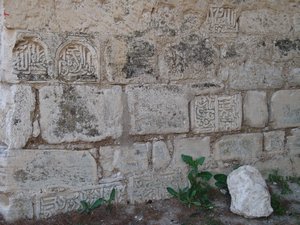 Once you find it, however, you will see glorious stone walls and towers standing virtually intact on a slight rise.
Once you find it, however, you will see glorious stone walls and towers standing virtually intact on a slight rise.
Although there had been a castle on the site for centuries, it was completely destroyed by the Ottoman leader Gedik Ahmed Paşa in 1471 after long years in which the Ottomans and the Karamanoğlus slugged it out with each other for supremacy.
Ahmed went on to wipe out much of the old town, reusing the stones to create a new castle. Today the walls are an extraordinary patchwork of stone; slabs of ancient inscription were set into them at all angles, with care taken only to ensure that the word “Allah” was always placed the right way up.
The castle was restored in 2015. Parts of the outer walls also survive albeit in a heavily tagged state. Just inside the walls the Pir Ahmet Cami (1547) and the attached bathhouse where also restored in 2015.
The castle is a primarily Ottoman structure. Elsewhere in town it is mainly buildings surviving from Karamanoğlu times that catch the eye. The two most remarkable are the Hatuniye Medrese and the İbrahim Bey Cami.
The Hatuniye Medrese was built for Nefise Sultan, wife of Karamanoğlu Emir Alaeddin Ali Bey and daughter of Ottoman Sultan Murad I, in 1382, and features a superb stone portal. It is now being used by the Turkish Language and Literature Association but the door is usually open to let visitors in to admire a pair of stone doorways as elaborate as anything in Mardin. One is even said to have provided inspiration for the detail in Osman Hamdi Bey’s famous painting, The Tortoise Trainer, in the Pera Museum in İstanbul.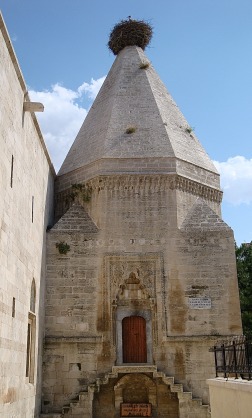
The artist apparently found equal inspiration in the İbrahim Bey Cami (otherwise known as the İmaret Cami), which dates back to 1433 and the reign of Karamanoğlu Emir İbrahim Bey II. This glorious if somewhat austere complex features a soaring, tile-adorned minaret, a graceful fountain facing the porch and a delicate lantern that adorns the central dome. Immediately behind it stands the tomb of the founder, and it is the interior of this tomb that Osman Hamdi Bey went on to paint.
For a town so overlooked by the outside world, Karaman has had more than its fair share of famous residents, amongst them Yunus Emre (c. 1238-1320), the poet who is believed to be buried beside the Yunus Emre Cami. A small adjacent park is adorned with quotations from his verse.
In 1222, the Sufi preacher Bahaeddin Veled arrived in town with his family, and the Karamanoğlu emir built a medrese to accommodate them. Veled’s son was the famous Mevlana, Celaddin Rumi, who married his wife, Gevher Hatun, while his family was living in Karaman.
It was here, too, that Mevlana’s mother died in 1224. Today she is buried, along with other family members, in the Aktekke Cami (also known as the Mader-i Mevlana Cami), built by Alaeddin Ali Bey to replace the original medrese in 1370.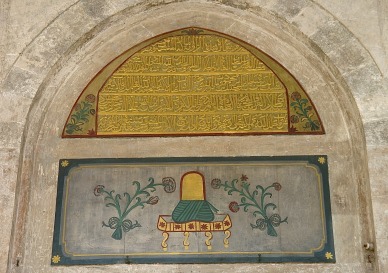
Beside the Hatuniye Museum is Karaman’s small archaeology and ethnography museum (closed Mondays) which exhibits the somewhat gruesome naturally mummified corpse of a young woman found in the cave settlement at Manazan, near Taşkale.
In the town centre beside Cumhuriyet Park the fine stone building that once housed the Belediye now serves as a small local museum with reminders of the crafts once carried on in the area.
Other sights around town include the Çeşmeli Cami, originally built as a church and used as such until the population exchange of 1923. It then served time as a prison but has now been beautifully restored to provide temporary exhibition space.
Nearby the restored Tartanzade Konağı may not look like much from the outside. Inside, however, it’s another matter with the mansion’s rooms and murals beautifully restored (even if the mannequins are a bit naff). Don’t miss it.
Of several bathhouses, the Süleyman Paşa, Hamamı beside the Aktekke Cami, still cleanses its customers beneath a conspicuously wide dome, while the Ottoman Yeni Hamamı has also been restored and reopened to the public.
In the centre of Karaman a modern monument reminds visitors that it was the Karamanoğlus who first adopted Turkish as their official language (the Selçuks had spoken Persian).
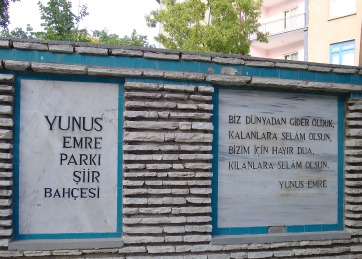
Eating
Right in the centre near the Aktekke Cami Birtat comes highly recommended by locals for its range of Turkish staples.
If you’re after a more contemporary style of dining there are several cafes and restaurants along İstasyon Caddesi that cater to a youthful clientele.
Sleeping
Aygun Otel. Tel: 0338-212 7700
Dilkent Otel. Tel: 0338-213 3900
Nadir Hotel. Tel: 0338-212 6969
Transport info
There are timetabled buses from Konya’s Karatay Otogar to Karaman as well as onward services to Adana and Ereğli.
To get here from Cappadocia isn’t quite as easy as you might hope. First you need to take a bus from Nevşehir to Niğde, then a second bus to Ereğli and a third to Karaman.
The otogar is some way from the town centre but serviced by frequent dolmuşes. Don’t expect to find much action when you get there – you’re best off buying a ticket online or from one of the bus company offices at the town-centre end of İstasyon Caddesi so that you know there will be a bus at the otogar to greet you.
There are infrequent train services to Adana and four services a day to Konya. The station is within walking distance of the town centre although dolmuses also pass by.
Day trip destinations

